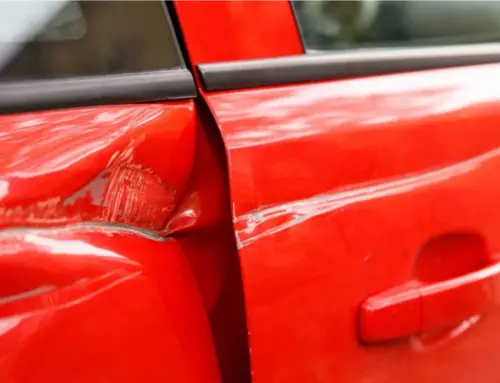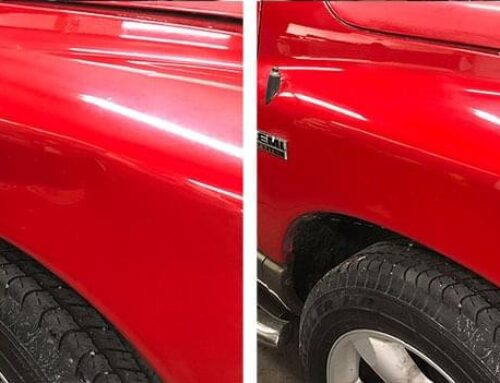Hail damage dent repair services restore car look and integrity by removing severe scratches and dents produced by hailstorms. Hail damage can leave deep scratches on a vehicle’s paint, exposing the metal to rust and corrosion. Hail damage repair professionals use specific instruments and techniques to analyze the damage and fix the affected sections. Paintless dent repair (PDR) preserves the vehicle’s factory gloss and value by massaging the dented metal back into form without sanding, filling, or repainting.
Hail damage dent repair services may repair dents, dings, paint chipping, and severe scratches. These procedures preserve the vehicle’s appearance and value by repairing its exterior.
Untreated hail damage can worsen the vehicle’s exterior and cause structural difficulties, so timely repair is essential. Hail damage dent repair services are a cost-effective and efficient way to remove severe scratches and restore hail-damaged vehicles.
Can hail damage dent repair techniques effectively remove deep scratches from vehicle surfaces?
Hail damage dent repair techniques primarily address dents and dings caused by hailstorms rather than deep scratches. While these techniques, such as paintless dent repair (PDR), can be highly effective in restoring the smooth surface of a vehicle’s body panels by gently massaging out dents without painting, they may not be suitable for repairing deep scratches. Deep scratches often penetrate the vehicle’s paint and primer layers, requiring more extensive repair methods such as sanding, filling, and repainting to achieve a seamless finish.
However, some hail damage repair facilities may offer additional services or alternative techniques to address deep scratches in conjunction with dent repair. These services may involve spot painting or blending techniques to repair scratched areas while maintaining the integrity of the surrounding paint finish. It’s essential to consult with a qualified hail damage repair technician to assess the extent of the damage and determine the most appropriate repair approach for deep scratches on a vehicle’s surface.
What are the primary methods used to address deep scratches in hail damage dent repair?
In hail damage dent repair, addressing deep scratches typically involves combining techniques to restore the damaged area to its original condition. The primary methods used to address deep scratches include:
- Spot Painting: Spot painting involves applying paint to the scratched area using precise techniques to match the color and texture of the surrounding paint. This method effectively covers up shallow scratches and restores the vehicle’s appearance.
- Sanding and Buffing: For deeper scratches that have penetrated the clear coat and paint layers, technicians may use sanding and buffing techniques to smooth out the damaged area. This process involves carefully sanding down the scratched surface to remove imperfections and then buffing it to restore shine and smoothness.
- Filler Application: In cases where scratches are too deep to be addressed with spot painting alone, technicians may apply a filler material to fill in the damaged area before painting. The filler helps to level out the surface and create a smooth foundation for the paint.
- Repainting: In severe cases where scratches are extensive or affect a large area of the vehicle’s surface, technicians may need to repaint the affected panels entirely. This process involves sanding down the damaged paint, applying primer, basecoat, and clearcoat layers, and blending the new paint with the surrounding areas for a seamless finish.
Depending on the severity and extent of the scratches, these methods may be used individually or in combination. Technicians must carefully assess the damage and select the most appropriate repair approach to ensure optimal results.
Are there specific considerations or limitations when repairing deep scratches alongside hail damage?
When repairing deep scratches alongside hail damage, there are several considerations and limitations that technicians need to take into account to ensure effective and satisfactory results:
- Extent of Damage: Technicians must carefully assess the importance of the deep scratches and hail damage to determine the most appropriate repair approach. Deep scratches penetrating through multiple layers of paint may require more extensive repair methods, such as sanding, filling, and repainting, compared to shallow scratches.
- Paint Matching: Achieving a seamless paint match is crucial when repairing deep scratches alongside hail damage to ensure uniformity and consistency in the vehicle’s appearance. Technicians must use precise color-matching techniques and high-quality paint materials to blend the repaired areas with the paint finish.
- Surface Preparation: Proper surface preparation ensures that the repaired areas adhere properly and blend seamlessly with the rest of the vehicle’s surface. This may involve thorough cleaning, sanding, and priming to create a smooth and even surface for painting.
- Time and Cost: Repairing deep scratches alongside hail damage may require additional time, labor, and materials, which can impact the overall cost of the repair. Technicians should provide precise estimates and communicate any potential delays or extra expenses to the vehicle owner before proceeding with the repair.
- Paint Condition: The condition of the vehicle’s paint, including its age, condition, and previous repairs, can influence the effectiveness of the repair process. Technicians may need to take extra precautions or perform additional steps to ensure that the repaired areas blend seamlessly with the rest of the paint finish.
By considering these factors and limitations, technicians can develop a tailored repair plan that effectively addresses the deep scratches and hail damage while ensuring the integrity and appearance of the vehicle’s paint finish. Regular communication with the vehicle owner is also essential to manage expectations and ensure satisfaction with the repair outcome.
How do professionals assess the severity of deep scratches during hail damage dent repair processes?
Professionals assess the severity of deep scratches during hail damage dent repair processes through a systematic examination of the affected areas. Here’s how they typically conduct this assessment:
- Visual Inspection: Technicians begin by visually inspecting the damaged areas to evaluate the depth, length, and extent of the scratches. They examine the scratches under various lighting conditions to identify any imperfections or irregularities that may affect the repair process.
- Tactile Examination: In addition to visual inspection, technicians may use their sense of touch to assess the severity of deep scratches. They run their fingers along the scratched surface to feel for any roughness, grooves, or unevenness caused by the scratches. This tactile examination helps determine the depth of the scratches and whether they have penetrated through the paint layers.
- Paint Thickness Measurement: Professionals may use paint thickness gauges or meters to measure the thickness of the paint layers in the scratched areas. This measurement helps determine the depth of the scratches and whether they have damaged the underlying paint and primer layers.
- Magnified Inspection: For detailed assessment, technicians may use magnifying tools such as microscopes or high-resolution cameras to examine the scratches closely. This magnified inspection allows them to identify microscopic damage and fine details that may not be visible to the naked eye.
- Documentation: Throughout the assessment process, professionals document their findings, including the size, location, and severity of the deep scratches. This documentation helps guide the repair process and ensures that all damaged areas are addressed effectively.
By combining visual inspection, tactile examination, paint thickness measurement, magnified inspection, and documentation, professionals can accurately assess the severity of deep scratches during hail damage and dent repair processes. This thorough assessment allows them to develop a tailored repair plan and select the most appropriate techniques and materials to restore the damaged areas effectively.
Deep Scratch Hail Damage Repair Solutions
Piedmont Dent Repair’s skilled technicians specialize in meticulously addressing deep scratches caused by hail damage, restoring your vehicle’s appearance to its pre-damaged condition. Using advanced techniques and precision tools, we blend the repaired areas with the surrounding paint finish, ensuring a flawless result.
Trust Piedmont Dent Repair for professional, reliable, and efficient deep scratch hail damage repair solutions that exceed your expectations. Please schedule your appointment today and let us revitalize your vehicle’s appearance with our expert services.






